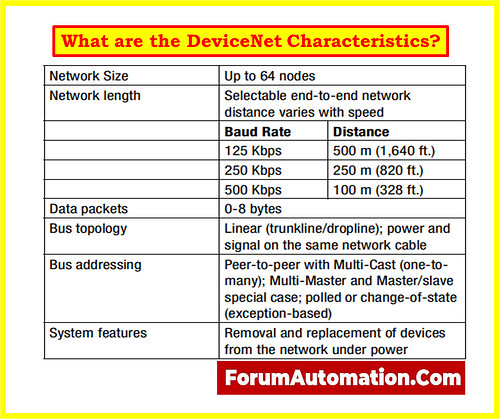What is DeviceNet?
- DeviceNet is a popular industrial networking solution that simplifies the wiring and installation of industrial equipment, improves interoperability, and provides a cost-effective way of connecting numerous components from various suppliers.
- DeviceNet, which was built on the Controller Area Network (CAN) protocol, uses an 11-bit identification standard and is distinguished by its open network standard, which allows suppliers to connect devices without purchasing specialized hardware, software, or license rights.
- DeviceNet uses an 11-bit identification structure, with 5 bits for message type and 6 bits for Media Access Control (MAC) ID.
- This configuration provides for 32 different message types and 64 distinct addresses.
- This simplicity enables that industrial equipment can be easily interchanged while also allowing more complicated devices to be connected.
What are the DeviceNet Characteristics?
Here are some of DeviceNet important characteristics:
Open Network Standard:
- Because the DeviceNet definition and protocol are open, companies are not required to invest in proprietary technology.
- This open approach promotes widespread adoption and compatibility across manufacturers.
Broadcast-Oriented Communication:
- DeviceNet employs a CAN-based broadcast-oriented communication protocol, which is widely utilized in a variety of industries.
- This method simplifies data transmission over the network and ensures that information is delivered efficiently to all relevant devices.
Scalability
- DeviceNet can accommodate up to 64 nodes, allowing several devices in an industrial context to be connected.
- Because of its scalability, it is appropriate for applications ranging from small systems to bigger, more sophisticated configurations.
Bus Topology
- DeviceNet’s physical topology is typically a straight bus with limited drops.
- This approach simplifies the network topology and decreases the complexity of the wiring.
Communication Speed and Distance
- DeviceNet provides communication speed and distance flexibility.
- It has transmission rates of 125, 250, and 500 kbps, with the maximum distance varying proportionally.
- A full trunk line, for example, can extend up to 500 meters at 125 kbps.
Error Detection and Correction
- To ensure data integrity, DeviceNet incorporates error detection and correction algorithms.
- It detects errors using CRC (Cyclic Redundancy Check) and asks retransmission in the event of errors.
Address Conflict Detection
- DeviceNet nodes indicate their addresses on startup to avoid address conflicts.
- If a duplicate address is found, the duplicate node will not enter run mode.
Address Configuration
- Nodes’ addresses can be configured offline using handheld programmers or online via the interface master.
- Because of this adaptability, nodes can be simply added into the network.
Node Parameter Programming
- DeviceNet allows for extensive node parameter programming, allowing for fine-tuning of device settings such as drive/rotational and instrument parameters.
DeviceNet’s history may be traced back to its early days with Allen-Bradley, which was essential in its development. In later stage technology was transferred to the Open DeviceNet Vendors Association (ODVA), allowing for further improvement and widespread implementation.
DeviceNet is a versatile industrial networking technology that provides benefits such as increased design flexibility, instrument interoperability, and reduced wiring, resulting in lower installation costs. Its open nature, scalable architecture, and strong error handling make it a popular choice in industrial automation, letting varied devices to successfully communicate inside a network.

